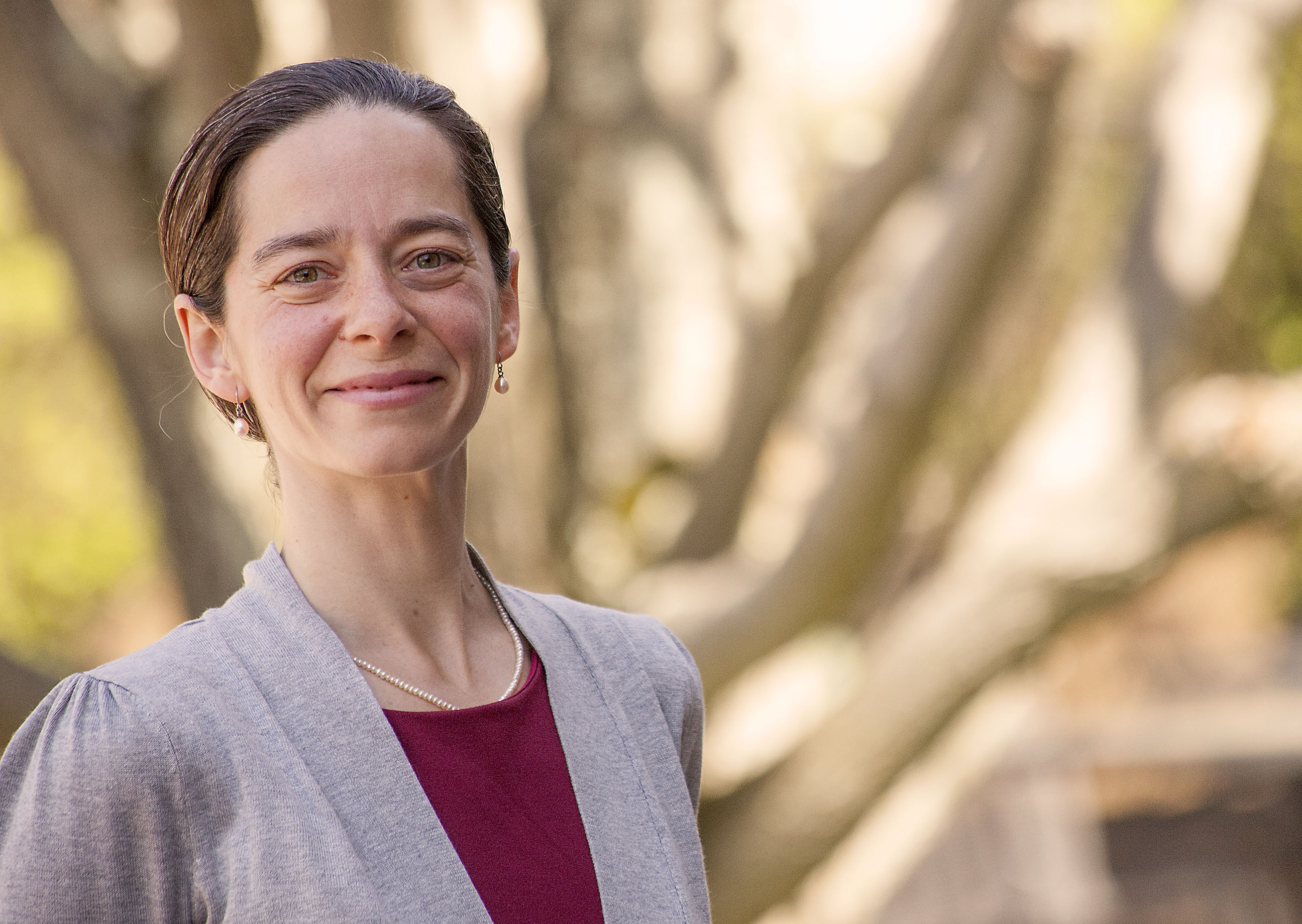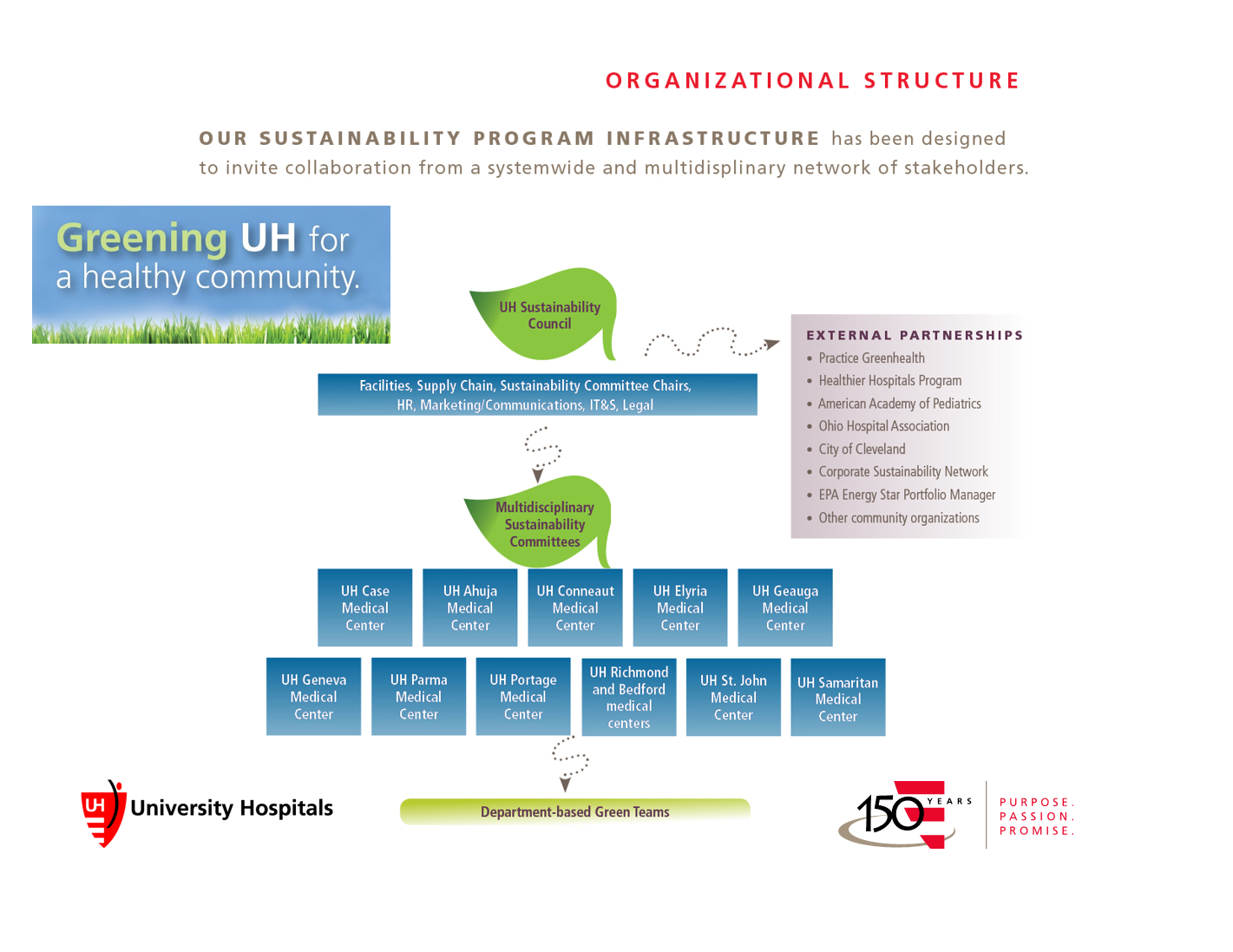Sarah O’Keeffe Is Creating Space for People and Planet to Thrive
by Helaine Alon
Being part of the sustainable healthcare movement that is working to move markets through sustainable business practices is one of the many gratifying co-benefits for Sarah E. O’Keeffe, MBA, in her role as Sustainability Manager for University Hospitals Health System (UH). “The value mission of healthcare institutions to heal underlies the strength of purchasing and other business actions to influence various product markets as well as public policy. This is especially true when actions directly relate to health impacts, as is the case with examples such as promoting healthier transportation choices or purchasing for healthy interiors” states Sarah.

Not long after starting her own project work in furnishings procurement, Sarah’s librarian husband asked for input on the content of children’s furniture options presented by suppliers to his library. While Sarah was not entirely surprised to see that options presented were mainly composed of vinyl (PVC), a long-used material in “durable” furnishings, she was concerned that proposed options contained at least one, if not more, of the other harmful chemicals and materials targeted in the national Healthier Hospitals Safer Chemicals Challenge (flame retardants, formaldehyde, perfluorinated compounds, and antimicrobials) and they were being touted as “commonly used in healthcare.” In fact, healthcare has been working to reduce and eliminate those very chemicals from hospital furnishing purchases through the Healthier Hospitals program, and UH had been largely successful in finding furniture and furnishings similar to those needed by the library that were completely free of these chemical compounds. Sarah’s husband was able to refer his supplier to this up-to-date example of the healthcare industry purchasing products without harmful chemicals and alternate furnishings were found.
Sarah is part of a dedicated three person team making up UH’s Office of Sustainability - Sustainability Specialist, Matthew Pietro, and the sustainability program founder and pediatrician, Dr. Aparna Bole, now in an advisory role for the program. Sarah describes their work as coordinating “sustainability initiatives that create health and wellness throughout the hospital... we motivate, educate, and communicate with people so that they themselves identify with the initiatives as well as implement them into their daily work.”
A system-level Sustainability Council includes facilities, supply chain, operations, IT, environmental safety, human resources, marketing, and clinical representation. Together they develop sustainability goals with leaders from each of the medical center-based multidisciplinary Sustainability Committees and the respective department-based Green Teams for implementation at the facility-level. Since the UH system is widespread, consisting of sites with unique characteristics across 15 hospitals, 29 outpatient health centers and numerous primary care physician offices in 15 Ohio counties, each of its facility-based Sustainability Committees has the flexibility to determine its own approach to fulfilling system identified goals as well as creating and implementing their own specific goals. External partnerships with member organizations such as Practice Greenhealth (PGH) and the Ohio Hospital Association, with professional organizations such as the American Academy of Pediatrics, and community connections such as the City of Cleveland’s Sustainable Cleveland 2019 Initiative, help inform the Council and Committee members of current and relevant sustainability topics and opportunities.

UH is signed on to all six of the Healthier Hospitals Challenge Areas and has achieved impressive results around the Safer Chemicals Challenge. Aiming to improve indoor air quality and promote human and environmental health, institutions are challenged to phase out products using chemicals associated with a range of adverse health outcomes. As highlighted in a 2014 Case Study from PGH, UH was among leading health systems nationwide to commit to avoiding the purchase of furniture containing chemical flame retardants, including carcinogenic and neurodevelopmental toxicants, while still meeting fire safety codes.
Specifically, from 2013 to 2014, systemwide furniture purchases free of these chemicals rose from 64% to 71%, in the free-standing furniture and furnishings category, and further to 78% in 2015. The amount of non-disinfectant green cleaners purchased relative to total non-disinfectant cleaners increased from 30% to 79% in 2014. All mercury-containing devices have been removed where possible and replaced with safer alternatives, and mercury management and purchasing policies outline safe handling of mercury and limit the purchase of mercury containing devices. This impressive work has helped earn UH six awards from PGH in 2016 alone, including a fifth consecutive System for Change award for leadership in comprehensive sustainability strategy.
UH’s work in the Healthier Hospitals program has helped the system think about greener and safer materials in all aspects of their operations, including furnishings, green cleaners, medical devices, and beyond. The Quentin & Elisabeth Alexander Neonatal Intensive Care Unit (NICU) at UH Rainbow Babies & Children’s Hospital, where UH has eliminated PVC-containing di(2-ethylhexyl)phthalate (DEHP), is one example. During a recent renovation in the NICU Step Down unit, an engaged supply chain champion inquired as to whether the vendor had any PVC-free and DEHP-free flooring. While it did take an extra week or so for delivery and installation, the cost neutral PVC-free flooring was installed not only in the NICU Step Down unit but on several other floors of an adjoining hospital of the same medical center that will be undergoing renovation in the near future. As a 2016 target for their sustainability initiatives, it is safe to say that greener flooring will be on the supply list for many more UH renovations to come.
Interdisciplinary collaboration across diverse stakeholder groups is key to strengthening UH’s sustainability work. The Office of Sustainability pursues collaboration by “facilitating a process that inspires thorough analysis and critical thinking, weighing the costs and benefits of new products and processes or best practices that are marketed as beneficial for the environment and health.” Sarah adds that “evaluating opportunities may come down to needed staff time and budget. If an eco-friendly product is cost neutral or a process saves time or money, those are very persuasive attributes that we communicate along with the health and environmental benefits in order to better spread the word that ‘eco-friendly’ does not always mean ‘more costly’ or ‘added on work.’” Recently, the supply chain manager referred a vendor to the Office of Sustainability for additional education on whether or not their product attributes were aligned with the greater sustainability mission. This illustrates the incredible commitment for internal and thoughtfully engaged stakeholders to embrace greener and healthier materials, once they understand the connection between improved indoor air quality and reduced exposures to harmful chemicals in products.
A Taste of What Lies Ahead for University Hospitals in 2016: UH aims to make safer chemicals purchasing more systematic by integrating regular educational updates for stakeholders on the direct health impacts connected to key initiatives. UH will also continue working with their Group Purchasing Organization to integrate more information on green attributes of products into contracts so there is less legwork for the staff members. They also hope to expand the use of PVC/DEHP-free exam gloves systemwide, as well as increase the use of triclosan-free soap following a successful pilot at the UH Rainbow Babies & Children’s Hospital. Additionally, they plan to continue collaborating with community partners in furthering green landscaping and integrated pest management programs.
Creative and consistent interactive employee engagement programs play an important role in educating and motivating UH staff. Engaging events, such as a relaxing “microbead free” eco-friendly spa in the cafeteria and educating employees and the public on plastic-free waters, provide opportunities for people to directly engage with the topics and understand the broader impact their individual actions can have. Sarah emphasizes that by taking the extra time to make the work personal for each staff person, patient, and visitor, it allows these stakeholders to take more ownership of systemwide sustainability efforts. For Sarah, the impact that she is able to make from inside the health system is motivating, how one decision can touch so many lives. “This goes beyond just standing on the street holding a 'No Chemicals!' sign - even though that is important too,” she says, “There are many opportunities for real change that come from working within a wide community and building strong relationships.”
According to the most recent Office of Sustainability 2014 Progress Report, UH is “...making a commitment not only to our stakeholders of today, but also to future generations, that we will do our part to steward a healthy environment for them to inherit." Sarah views her job with UH and her work within the greater sustainable healthcare movement through this vantage point. “I truly believe that it is possible for us to all thrive and live high quality lives on this planet without compromising our own health and the health of the planet,” she says. For now, she and her colleagues are making their mark within healthcare and helping to lead the way toward a sustainable future, one purchase and best practice at a time.
 Helaine Alon provides communications support for the Safer Chemicals team
Helaine Alon provides communications support for the Safer Chemicals team
